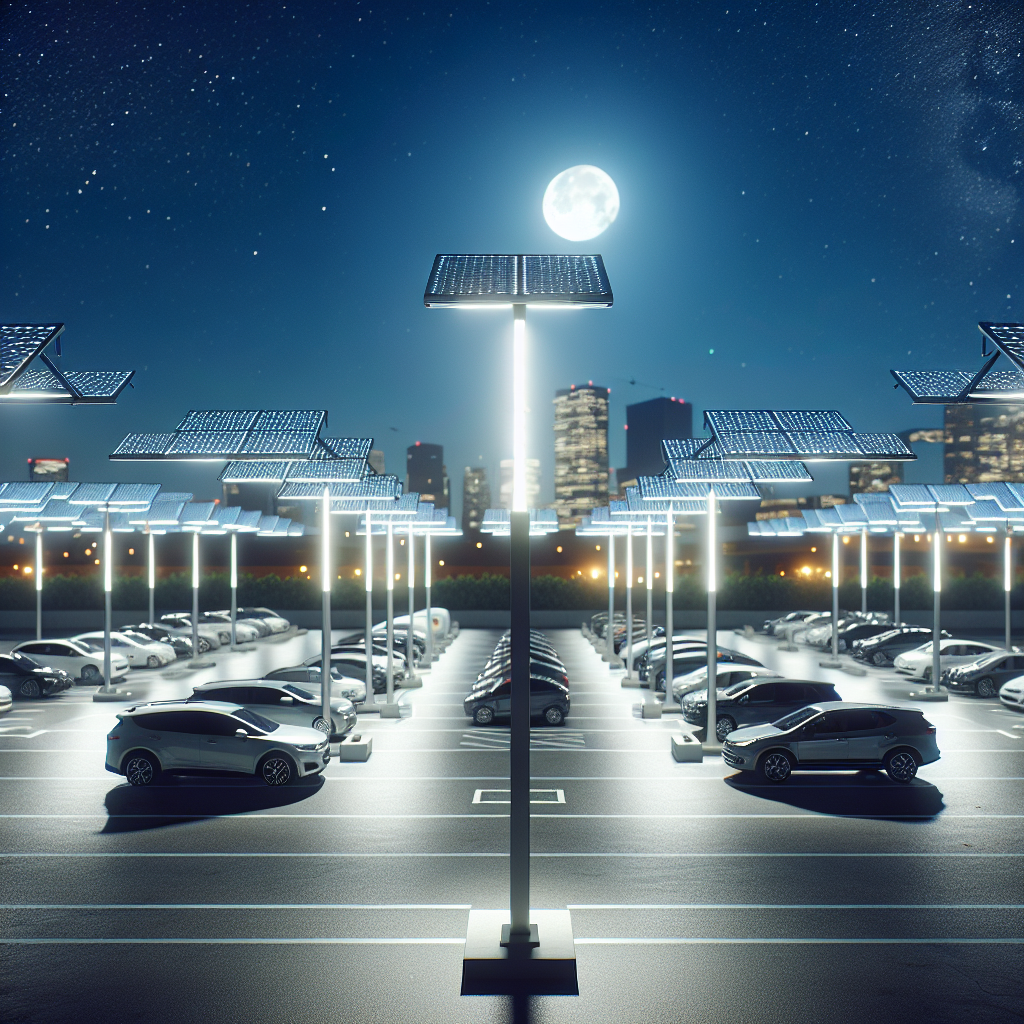Temporary Solar Lighting for Parking Lots and Garages
-
Table of Contents
Temporary solar lighting for parking lots and garages offers an efficient, eco-friendly solution for illuminating these spaces without the need for permanent electrical infrastructure. These systems harness solar energy through photovoltaic panels, storing power in batteries to provide consistent lighting during nighttime or low-light conditions. Ideal for construction sites, events, or emergency situations, temporary solar lighting is easy to install, cost-effective, and reduces carbon footprints. By utilizing renewable energy, these lighting solutions not only enhance safety and visibility but also contribute to sustainable practices in urban and suburban environments.
Benefits Of Temporary Solar Lighting For Parking Lots And Garages
Temporary solar lighting for parking lots and garages offers a multitude of benefits that extend beyond mere illumination. As urban areas continue to expand and the demand for sustainable solutions grows, the adoption of solar lighting systems has become increasingly prevalent. These systems are not only environmentally friendly but also economically advantageous, making them an attractive option for both public and private entities.
One of the primary benefits of temporary solar lighting is its environmental impact. Unlike traditional lighting systems that rely on fossil fuels, solar lighting harnesses energy from the sun, a renewable resource. This significantly reduces carbon emissions and helps mitigate the effects of climate change. By opting for solar lighting, organizations can demonstrate their commitment to sustainability and environmental stewardship, which can enhance their public image and align with corporate social responsibility goals.
In addition to environmental benefits, temporary solar lighting systems are cost-effective. The initial investment in solar technology may be higher than conventional lighting; however, the long-term savings are substantial. Solar lights do not require electricity from the grid, which means there are no ongoing energy costs. Furthermore, maintenance expenses are generally lower because solar lighting systems have fewer moving parts and are designed to withstand harsh weather conditions. Over time, the reduction in energy and maintenance costs can lead to significant financial savings.
Another advantage of temporary solar lighting is its ease of installation and flexibility. Traditional lighting systems often require extensive wiring and infrastructure, which can be both time-consuming and disruptive. In contrast, solar lighting systems are typically wireless and can be installed quickly with minimal disturbance to the surrounding area. This makes them an ideal solution for temporary or emergency situations, such as construction sites, special events, or natural disasters. The portability of solar lighting units also allows for easy relocation, providing a versatile lighting solution that can be adapted to changing needs.
Moreover, temporary solar lighting enhances safety and security in parking lots and garages. Adequate lighting is crucial for preventing accidents and deterring criminal activity. Solar lights can be strategically placed to illuminate dark areas, improving visibility for both pedestrians and drivers. This not only reduces the risk of accidents but also creates a safer environment for users. Enhanced lighting can also deter potential criminals, as well-lit areas are less attractive targets for theft and vandalism. By improving safety and security, solar lighting can contribute to a more positive user experience and increase the overall appeal of a facility.
Furthermore, the use of temporary solar lighting can contribute to compliance with regulatory requirements. Many jurisdictions have implemented regulations aimed at reducing energy consumption and promoting the use of renewable energy sources. By adopting solar lighting, organizations can ensure they are in compliance with these regulations, avoiding potential fines and penalties. Additionally, some governments offer incentives and rebates for the installation of solar lighting systems, further offsetting the initial investment and making the transition to solar more financially feasible.
In conclusion, temporary solar lighting for parking lots and garages presents numerous benefits that make it a compelling choice for modern lighting needs. Its environmental advantages, cost-effectiveness, ease of installation, and contribution to safety and security underscore its value as a sustainable and practical solution. As the world continues to prioritize sustainability and energy efficiency, the adoption of solar lighting systems is likely to become increasingly widespread, offering a brighter and greener future for all.
Installation Tips For Temporary Solar Lighting In Parking Areas

When considering the installation of temporary solar lighting in parking areas, it is essential to approach the task with a comprehensive understanding of both the technology and the specific requirements of the site. Temporary solar lighting offers a sustainable and cost-effective solution for illuminating parking lots and garages, particularly in situations where permanent lighting infrastructure is either impractical or unnecessary. To ensure a successful installation, several key factors must be taken into account, ranging from site assessment to the selection of appropriate equipment.
First and foremost, a thorough site assessment is crucial. This involves evaluating the layout of the parking area, identifying potential obstructions, and determining the optimal locations for the solar lights. It is important to consider the amount of sunlight the area receives throughout the day, as this will directly impact the efficiency and performance of the solar lighting system. Areas that are heavily shaded or receive limited sunlight may require additional planning or alternative solutions to ensure adequate illumination.
Once the site assessment is complete, the next step is to select the appropriate solar lighting equipment. Temporary solar lighting systems typically consist of solar panels, batteries, LED lights, and control units. When choosing these components, it is important to consider factors such as the brightness and coverage area of the lights, the capacity and lifespan of the batteries, and the efficiency of the solar panels. High-quality LED lights are recommended for their energy efficiency and long lifespan, while batteries with sufficient capacity are essential to ensure that the lights can operate throughout the night.
The installation process itself should be approached with careful planning and attention to detail. Begin by positioning the solar panels in locations where they will receive maximum sunlight exposure. This may involve mounting the panels on poles, rooftops, or other elevated structures to avoid obstructions and optimize energy capture. It is also important to ensure that the panels are securely fastened and angled correctly to maximize their efficiency.
Next, install the LED lights in the predetermined locations, ensuring that they are positioned to provide even and adequate coverage of the parking area. The lights should be mounted at a height that minimizes glare and maximizes visibility for both pedestrians and vehicles. Additionally, it is important to consider the placement of the control units and batteries, ensuring that they are protected from the elements and easily accessible for maintenance.
To enhance the performance and reliability of the temporary solar lighting system, it is advisable to incorporate smart controls and sensors. These can include motion sensors, which activate the lights only when movement is detected, thereby conserving energy and extending battery life. Timers and dimmers can also be used to adjust the lighting levels based on the time of day or specific usage patterns, further optimizing energy consumption.
Finally, regular maintenance is essential to ensure the continued performance of the temporary solar lighting system. This includes cleaning the solar panels to remove dust and debris, checking the batteries for signs of wear or damage, and inspecting the LED lights and control units for any issues. By conducting routine maintenance, potential problems can be identified and addressed promptly, ensuring that the lighting system remains effective and reliable.
In conclusion, the installation of temporary solar lighting in parking areas requires careful planning, the selection of appropriate equipment, and diligent maintenance. By following these guidelines, it is possible to create a sustainable and efficient lighting solution that enhances safety and visibility while minimizing environmental impact and operational costs.
Cost-Effectiveness Of Temporary Solar Lighting Solutions For Garages
Temporary solar lighting solutions for parking lots and garages have emerged as a cost-effective alternative to traditional lighting systems. These innovative solutions offer numerous financial benefits, making them an attractive option for businesses and property managers. One of the primary advantages of temporary solar lighting is the significant reduction in energy costs. Unlike conventional lighting systems that rely on electricity from the grid, solar lighting harnesses energy from the sun, which is both abundant and free. This translates to substantial savings on monthly utility bills, especially in large parking areas where lighting is required for extended periods.
Moreover, the installation of temporary solar lighting systems is generally less expensive compared to traditional wired lighting. Traditional systems often necessitate extensive groundwork, including trenching and wiring, which can be both time-consuming and costly. In contrast, solar lighting units are typically self-contained and can be installed with minimal disruption. This ease of installation not only reduces labor costs but also minimizes downtime, ensuring that parking lots and garages remain operational during the transition.
In addition to the initial cost savings, temporary solar lighting solutions also offer long-term financial benefits. Solar lighting systems are designed to be durable and require minimal maintenance. The absence of complex wiring and electrical components reduces the likelihood of malfunctions and the need for repairs. Furthermore, many solar lighting units come equipped with LED bulbs, which have a longer lifespan compared to traditional incandescent or fluorescent bulbs. This longevity translates to fewer replacements and lower maintenance costs over time.
Another aspect contributing to the cost-effectiveness of temporary solar lighting is the potential for tax incentives and rebates. Many governments and local authorities offer financial incentives to encourage the adoption of renewable energy solutions. These incentives can significantly offset the initial investment in solar lighting systems, making them even more affordable. Additionally, businesses that implement solar lighting may also benefit from enhanced corporate social responsibility (CSR) profiles, which can attract environmentally-conscious customers and investors.
It is also worth noting that temporary solar lighting solutions provide flexibility and scalability. As the needs of a parking lot or garage change, solar lighting units can be easily relocated or adjusted to accommodate new configurations. This adaptability ensures that businesses can optimize their lighting solutions without incurring additional costs. For instance, during special events or peak seasons, additional solar lighting units can be deployed to enhance visibility and safety, and subsequently removed when no longer needed.
Furthermore, the environmental benefits of solar lighting cannot be overlooked. By reducing reliance on fossil fuels and decreasing carbon emissions, businesses contribute to a more sustainable future. This commitment to sustainability can enhance a company’s reputation and potentially lead to cost savings through reduced environmental impact fees or compliance costs.
In conclusion, temporary solar lighting solutions for parking lots and garages offer a multitude of cost-effective advantages. From reduced energy bills and lower installation costs to minimal maintenance and potential tax incentives, these systems present a financially viable option for businesses seeking efficient and sustainable lighting solutions. The flexibility and environmental benefits further enhance their appeal, making temporary solar lighting a prudent investment for modern parking facilities.
┬Ā
Read more about Temporary Solar Lighting
- Introduction to Temporary Solar Lighting
- Advantages of Temporary Solar Lighting
- Temporary Solar Lighting for Events and Festivals
- Temporary Solar Lighting for Construction Sites
- Temporary Solar Lighting for Outdoor Recreation
- Temporary Solar Lighting for Disaster Relief
- Temporary Solar Lighting for Road and Highway Construction
- Temporary Solar Lighting for Military and Security Operations
- Choosing, Installing, and Maintaining Temporary Solar Lighting









